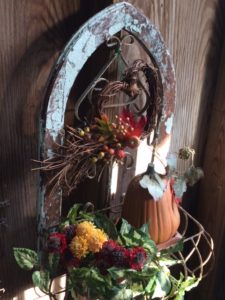 During summer months, when I park my car behind my building, I will often see my neighbor Paula on her knees, along a very narrow strip of grass by the fence, pulling weeds.
During summer months, when I park my car behind my building, I will often see my neighbor Paula on her knees, along a very narrow strip of grass by the fence, pulling weeds.
She loves to garden!
She’ll be wearing a colorful sweatshirt and clogs in a shade of orange or lavender or turquoise, matching one of the colors featured in the pattern of her leggings. Even the frame color of her eyeglasses will match.
I’ll tease her about this as we’ll catch up on small bits of very local news, things like rodent sightings near our dumpster or recent dining out adventures in nearby Lincoln Square.
“What can I say?” she’ll shrug. Referring to her occupation as an interior designer, she’ll add, “I can’t help it.”
When I pulled up to my parking space one day last week, I caught her just straightening up from a pleasant fall afternoon spent digging in the dirt. She was in an orange and black ensemble, suitable for the approach of Halloween, I suppose.
Having barely stepped out of my car, she took my hand and led me to a little nook under the redwood staircase leading up to the back decks on the second and third floors of our building.
“I want to show you something,” she said
In this small area, where my downstairs neighbors might keep a non-motorized scooter used by one of their kids and where I’ll be storing a shovel soon enough, Paula hung a fall decoration; something of her own design.
I’m usually not into folksy things. (Never buy me a basket and try to convince me that they’re wonderful for storing TV remotes.). I’m certainly not into churchy things.
But, the very sight of how she decorated this small space, seemed to cover me with a sweet quilt of quiet.
Along a wooden post, she hung a distressed metal chapel frame, about eighteen inches high. It bore different layers of paint, as if its owner could not make up her mind whether it should be painted or left a natural, rusted color.
A wire structure, jutted out from the bottom. It held a small vessel filled with dried or plastic flowers, in golden tones, and a flat dish which held a small elongated pumpkin.
I could also make out the silhouette of a heart made up of gathered tree stems. The brownish color of the heart blended into the background of this space under the staircase. Late afternoon light penetrated this usually forgotten place, and it really felt like I was in a sacred space.
She explained, “I wanted to show you this was here because you might miss it if you didn’t know to look for it.”
I had to think about what makes a place a sacred space.
- What you do there?
- What objects (that are meaningful for you) are there?
- What rituals do you perform there? What’s your intention for spending time there?
Of course, some spaces seem to be sacred because of intention and history.
When I was in Portugal a few years ago, I visited the town of Fatima. Amid what approached crass commerce, Madonna relics and key chains commemorating the miracle being sold on every street corner, I considered that I walked the same path decades of pilgrims walked and lingered in the glen where an innocent girl, under church pressure, would not change her story about seeing Mary.
There are also spaces that catch you surprise that seem to be sacred as well.
Perhaps a place you trip upon is overwhelmingly beautiful or inspirational.
This little alcove with its autumn-colored decoration struck me as a very special place.
Yes, I was pleased that I was one of only a handful of people who knew about it. In some way, it belonged to me and Paula and Josh and Alicia and just the people who live in our building.
It also represented a lot of work on Paula’s part. That was a little miracle to me, that someone would put so much effort and love into making something beautiful regardless of whether it is widely noticed or appreciated makes it a sacred space.
Acknowledging hours of often unrecognized work is no small thing.


Leave a comment